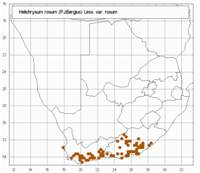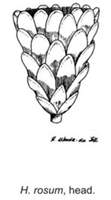Origin of name:
rosum/ -as = pink
Diagnostic characters:
Grey leaves Leaves inrolledSmall open branched inflorescences, heads on short stalksCream-coloured bracts
Description:
Well-branched or densely tufted subshrub up to c. 1 m tall, young stems thinly white-felted, closely leafy, at least some leaves with dwarf axillary shoots making the leaves look fascicled. Leaves mostly 8-25 x 1-3 (-5) mm, linear, linear-lanceolate or oblong-lanceolate, apex acute or subacute, base very shortly decurrent, margins revolute or subrevolute, often undulate-dentate, upper surface glabrous to thinly cobwebby-felted, often wrinkled, lower white-felted, the hairs often stringy, or occasionally loosely woolly above and below. Heads heterogamous, oblong-campanulate, c. 4 x 3 mm, few to many in compact corymbose panicles terminating the branchlets. Involucral bracts in 5-6 series, graded, inner about equaling the flowers, imbricate, bases pellucid, pale straw-coloured or tawny, tips blunt, opaque, milk-white, smooth or rarely slightly crisped, not radiating. Receptacle honeycombed. Flowers 15-28, 4-11 female, 8-21 homogamous. Achenes c. 0.75 mm, broadly cylindric, with myxogenic duplex hairs. Pappus bristles many, about equaling corolla, scabridulous, bases cohering by patent cilia.
Flowers mainly from September to December, but as late as March.
Distribution:
Ranges from about Stellenbosch (Visserhok) eastwards over the mountains flanking the Karoo to about Queenstown and through the coastal districts to about Kentani in the Transkei, on the flats or on the flanks of the mountains, in shrub communities, coastal renosterveld, valley bushveld or karroid scrub, or in grassland.
Fynbos, Thicket, Savanna, Grassland and Nama Karoo Biomes.
Notes:
Two varieties are recognized:
(a) var. rosum
(b) var. acutatum Hilliard
H. rosum var. rosum is characterized by its bushy growth, 'fascicled' leaves, and white-tipped involucral bracts that are usually smooth and concave; when the bract tips are crisped, as they occasionally are, confusion can arise with H. athrixiifolium which is indeed very closely allied to H. rosum and is distinguished morphologically by this bract character, and perhaps by a difference in habit that cannot be detected in the herbarium.
De Candolle singled out specimens with loosely woolly leaves as H. concolorum. However, variation in degree of woolliness is very common in Helichrysum; in H. rosum plants with the more usual type of leaf indumentum can grow with woolly-leaved specimens, and all degrees of woolliness are found over the range of the species. It is scarcely worth upholding the epithet concolorum even at varietal level, but the combination is available for use if desired.
H. rosum is much confused with H. rugulosum, but that species has simple or subsimple stems, rarely produces dwarf axillary shoots, and the teeth on the receptacle are longer than the ovaries. Also frequently confused with H. dregeanum; see under that species.
Taxonomy:
Literature:
Helichrysum rosum (Berg.) Less., Syn. Comp. 306 (1832); DC., Prodr. 6: 205 (1838); Harv. in F.C. 3: 251 (1865) as H. erosum; Moeser in Bot. Jb. 44: 282 (1910).
Type:
Cape of Good Hope, Grubb (STB, holo.).
Synonym(s):
Gnaphalium rosum Berg., Descr. Pl. Cap. 260 (1767). Helichrysum erosum var. angustifolium Harv. in F.C. 3: 251 (1865).
C. heterophyllum Thunb., Prodr. 149 (1800), Fl. Cap. 648 (1823). Helichrysum teretifolium var. heterophyllum (Thunb.) DC., Prodr. 6: 205 (1838). Type: Cape of Good Hope, Thunberg (sheet 19174, UPS, holo.).
G. erosum Thunb., Mus. Upsal. Append. VIII: 133 (1800), nomen. (Thunberg, sheet 19151, UPS; sheet 19152, also written up as erosum, is H. rugulosum).
Helichrysum concolorum DC., Prodr. 6: 206 (1838). Gnaphalium concolorum (DC.) Sch. Bip. in Bot. Ztg 3; 172 (1845). H. erosum var. concolorum (DC.) Harv. in F.C. 3: 251 (1865). H. rosumvar. concolorum (DC.) Moeser in Bot. Jb. 44: 282 (1910). Lectotype: Cape, George, Ecklon 665 (G-DC).
H, concolorum var. brevifolium DC., Prodr. 6: 206 (1838). Type: Cape, Van Staden's River and Algoa Bay, Dr�ge 5777 (G-DC, holo.; TCD, iso.).
H. erosum var. latifolium Harv. in F.C. 3: 251 (1865). No specimen cited, nor annotated in TCD.
Vouchers:
Acocks 9466 (PRE); Esterhuysen 13590 (PRE); MacOwan 593 (PRE; SAM); Pegler 1491 (BOL; PRE).


_sml.jpg)
_sml.jpg)
_sml.jpg)
_sml.jpg)